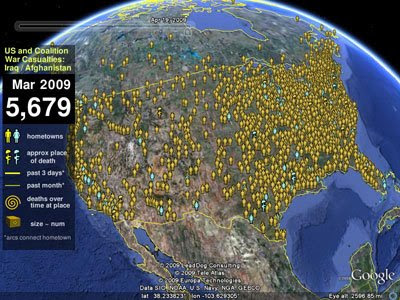For the past two years I've been working on the Google Earth Outreach team, aimed at helping non-profits and public benefit groups use Google Earth and Google Maps to further their cause. In that time I've worked on so many cool projects, from training indigenous communities in Brazil on the use of internet and mapping technologies, to helping with Google's disaster response mapping efforts for the San Diego fires and Cyclone Nargis, to even working with NASA to get a copy of Google Earth on the International Space Station (more on that later!). I'm also in charge of the Global Awareness layers in Google Earth and helped develop and polish many of those projects, including Crisis in Darfur and Appalachian Mountaintop Removal Coal Mining.
For this project I collected information from a number of sources, including the Department of Defense's Statistical Information Analysis Division, icasualties.org, MilitaryTimes.com's Honor the Fallen, Washington Post's Faces of the Fallen, the Iraq and Afghanistan Pages, and Legacy.com. I used the Google Maps and GeoNames.org geocoding services to get coordinates for each person's home of record and approximate place of death. The map includes data through March 2009. I'd like to point out the incredible time commitment the above organizations invest in maintaining this information; as I've learned, it is not an easy task. All of the data I have assembled and generated for this project will be made freely available for download in the near future.
During this project, I have sought the advice and perspectives of several groups directly tied to these losses, including Gold Star families, veterans' groups, active-duty servicemen and women, and leadership in the United States Army. I've done my best to incorporate their feedback and suggestions in creating something that pays tribute to the memory and service of these fallen heroes. Out of respect for the families of those people on this map who have taken their own lives, I have chosen to describe these deaths as coming from "non-combat" related causes. This is a broad category used by the Department of Defense to define other causes of death resulting from accidents or illness.
I recognize that this map is just a slice of the story in these conflicts. The Iraqi and Afghan people have incurred substantial civilian losses through these wars; there are also U.S. and Coalition civilians, contractors, and reporters who have died as well. For this project, I've chosen to focus on the U.S. and Coalition military casualties, but I recognize that the losses extend beyond what is mapped in this project. I also understand that there could be inaccuracies in this layer, and I'll be adding a method for submitting corrections very shortly.

So please take a look at this map, and explore the stories of heroism and sacrifice made across this nation and across the world. Although this map only shows the hometowns and places of death for these soldiers, it's important to remember that each of these servicemen and women have a rich story in between, which leads me to something a Gold Star mom recently shared with me:




